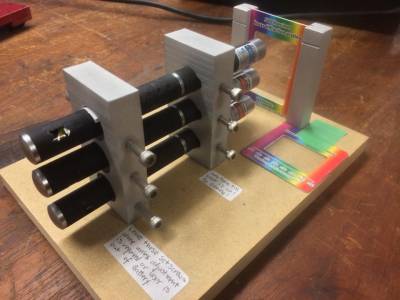User Tools
Table of Contents
3 Color Laser Array Through Diffraction Grating
Description
Three lasers of different wavelength1)) each pass through the same diffraction grating. Angle of diffraction differs for each color.
Purpose
This demonstration shows how the angle of diffraction varies with the wavelength of the incident light, and shows how longer (redder) wavelengths differ from shorter (bluer) wavelengths.
Apparatus
- 3-color laser array with diffraction grating
Setup
To turn the lasers on just screw in the screws above each of the lasers buttons. If the batteries need to be changed, unscrew all of the screws and pull the laser out the back. When return the laser pointer to the apparatus, use the rear screws to align the centers of the diffraction patterns with each other.
Notes
There are three lasers, 405nm (Blue), 532nm (Green), and 650nm (Red). When coherent light passes through a diffraction grating the light forms local maxima aligned with the horizontal plane (given that the grating is oriented vertically). The angle to the maxima is dependent on the wavelength of the coherent light passing through, and the distance between the slits in the grating.
The relation is the following:
d sin(θ) = nλ
Where “d” is the distance between slits in the grating, “θ” is the angle from the center to the respective maxima, “n” is the order of maxima in question, and “λ” is the wavelength of the light. The central maxima has n=0, and the first maxima on each side of the central maxima is referred to as the maxima of “order 1.”
Here's a video explanation of this demonstration.
Demo room information
| Location | B4 |
| Maker | Unknown |
| Current State | Working |

